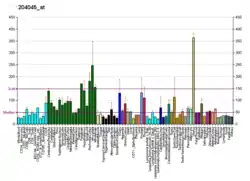TCEAL1
Transcription elongation factor A protein-like 1 is a protein that in humans is encoded by the TCEAL1 gene.[5][6][7]
| TCEAL1 | |||||||||||||||||||||||||
|---|---|---|---|---|---|---|---|---|---|---|---|---|---|---|---|---|---|---|---|---|---|---|---|---|---|
| Identifiers | |||||||||||||||||||||||||
| Aliases | TCEAL1, SIIR, WEX9, p21, pp21, transcription elongation factor A like 1 | ||||||||||||||||||||||||
| External IDs | OMIM: 300237 MGI: 2385317 HomoloGene: 3510 GeneCards: TCEAL1 | ||||||||||||||||||||||||
| |||||||||||||||||||||||||
| |||||||||||||||||||||||||
| |||||||||||||||||||||||||
| |||||||||||||||||||||||||
| Orthologs | |||||||||||||||||||||||||
| Species | Human | Mouse | |||||||||||||||||||||||
| Entrez | |||||||||||||||||||||||||
| Ensembl | |||||||||||||||||||||||||
| UniProt | |||||||||||||||||||||||||
| RefSeq (mRNA) | |||||||||||||||||||||||||
| RefSeq (protein) | |||||||||||||||||||||||||
| Location (UCSC) | Chr X: 103.63 – 103.63 Mb | Chr X: 136.71 – 136.71 Mb | |||||||||||||||||||||||
| PubMed search | [3] | [4] | |||||||||||||||||||||||
| Wikidata | |||||||||||||||||||||||||
| |||||||||||||||||||||||||
This gene encodes a member of the transcription elongation factor A (SII)-like (TCEAL) gene family. Members of this family may function as nuclear phosphoproteins that modulate transcription in a promoter context-dependent manner. The encoded protein is similar to transcription elongation factor A/transcription factor SII and contains a zinc finger-like motif as well as a sequence related to the transcription factor SII Pol II-binding region. It may exert its effects via protein-protein interactions with other transcriptional regulators rather than via direct binding of DNA. Multiple family members are located on the X chromosome. Alternative splicing results in multiple transcript variants encoding a single isoform.[7]
References
- GRCh38: Ensembl release 89: ENSG00000172465 - Ensembl, May 2017
- GRCm38: Ensembl release 89: ENSMUSG00000049536 - Ensembl, May 2017
- "Human PubMed Reference:". National Center for Biotechnology Information, U.S. National Library of Medicine.
- "Mouse PubMed Reference:". National Center for Biotechnology Information, U.S. National Library of Medicine.
- Yeh CH, Shatkin AJ (Jul 1994). "A HeLa-cell-encoded p21 is homologous to transcription elongation factor SII". Gene. 143 (2): 285–7. doi:10.1016/0378-1119(94)90112-0. PMID 8206389.
- Yeh CH, Shatkin AJ (Dec 1994). "Down-regulation of Rous sarcoma virus long terminal repeat promoter activity by a HeLa cell basic protein". Proc Natl Acad Sci U S A. 91 (23): 11002–6. doi:10.1073/pnas.91.23.11002. PMC 45154. PMID 7971997.
- "Entrez Gene: TCEAL1 transcription elongation factor A (SII)-like 1".
Further reading
- Yeh CH, Zong WX, Shatkin AJ (1995). "The Ser36-Ser37 pair in HeLa nuclear protein p21/SIIR mediates Ser/Thr phosphorylation and is essential for Rous sarcoma virus long terminal repeat repression". J. Biol. Chem. 270 (43): 25313–5. doi:10.1074/jbc.270.44.26558. PMID 7592688.
- Pillutla RC, Shimamoto A, Furuichi Y, Shatkin AJ (1999). "Genomic structure and chromosomal localization of TCEAL1, a human gene encoding the nuclear phosphoprotein p21/SIIR". Genomics. 56 (2): 217–20. doi:10.1006/geno.1998.5705. PMID 10051408.
- van der Kuip H, Carius B, Haque SJ, et al. (1999). "The DNA-binding subunit p140 of replication factor C is upregulated in cycling cells and associates with G1 phase cell cycle regulatory proteins". J. Mol. Med. 77 (4): 386–92. doi:10.1007/s001090050365. PMID 10353443.
- Strausberg RL, Feingold EA, Grouse LH, et al. (2003). "Generation and initial analysis of more than 15,000 full-length human and mouse cDNA sequences". Proc. Natl. Acad. Sci. U.S.A. 99 (26): 16899–903. doi:10.1073/pnas.242603899. PMC 139241. PMID 12477932.
- Gerhard DS, Wagner L, Feingold EA, et al. (2004). "The Status, Quality, and Expansion of the NIH Full-Length cDNA Project: The Mammalian Gene Collection (MGC)". Genome Res. 14 (10B): 2121–7. doi:10.1101/gr.2596504. PMC 528928. PMID 15489334.
- Ross MT, Grafham DV, Coffey AJ, et al. (2005). "The DNA sequence of the human X chromosome". Nature. 434 (7031): 325–37. doi:10.1038/nature03440. PMC 2665286. PMID 15772651.
- Makino H, Tajiri T, Miyashita M, et al. (2005). "Differential expression of TCEAL1 in esophageal cancers by custom cDNA microarray analysis". Dis. Esophagus. 18 (1): 37–40. doi:10.1111/j.1442-2050.2005.00432.x. PMID 15773840.
- Oh JH, Yang JO, Hahn Y, et al. (2006). "Transcriptome analysis of human gastric cancer". Mamm. Genome. 16 (12): 942–54. doi:10.1007/s00335-005-0075-2. PMID 16341674.
- Ewing RM, Chu P, Elisma F, et al. (2007). "Large-scale mapping of human protein–protein interactions by mass spectrometry". Mol. Syst. Biol. 3 (1): 89. doi:10.1038/msb4100134. PMC 1847948. PMID 17353931.




